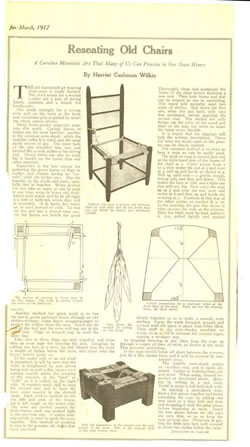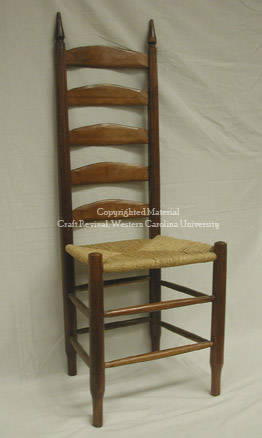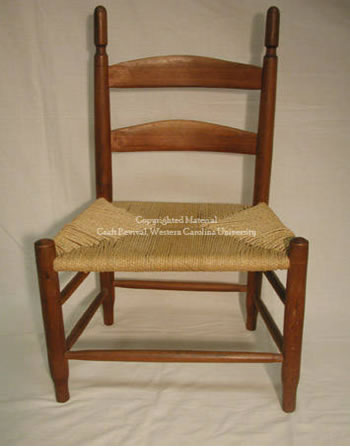Woodwork:
Chairs
Across the Appalachian South, the landscape and the character of its craftsmen have shaped a long and rich tradition of handmade products. Mr. Arval Woody of the well-known North Carolina family of craftsmen sums up his family tradition… “We get the tree in the forest, and when we finish it up it's in the living room.” 1 For many woodworkers who eschew the machination of “modern” production techniques, Arval’s words still ring true.
Comfort is the defining feature of a traditional southern Appalachia chair. Venerated North Carolina craftsman Birdie Mace distinguished the affectionately dubbed “settin’ chair” from its “ladderback” New England cousin, a chair with straight rear posts and slats which make a ladder-like design. Mace said, "If company comes, and you don’t want ‘em to stay long, well, you bring out one of them ladderbacks for ‘em to sit on. But if you want ‘em to set a spell and visit, well, offer ‘em a settin’ chair.” 2
The Appalachian chair, marked by rear posts which bend backwards and away from the woven seat, allows the sitter to lean back and engage in contemplative sitting.
While the sharp contrasts between regional forms is quite evident, it is important to note that there was also a generous flexibility of design within the traditional Appalachian style. While many southern craftsmen did adhered to the basic requirements of a “settin’ chair,” some employed a variety of unique adaptations; varying the number of slats and posts, adding rockers, or customizing a seat’s weave. This freedom in design and construction is as integral to the tradition as the original template itself. 3
To construct the comfortable chair, Appalachian craftsmen take advantage of the natural physical properties of wet (or green) wood, namely pliability and shrinkage. Well-seasoned (dried) rounds and rungs fit holes drilled into green posts. These curved support posts will contract while drying and clamp more and more tightly around the rounds. A great deal of skill and experience is required when forming the joints to avoid splitting the wood. The differentiation in moisture content allows for a tight fitting joint and the process eliminates the need to use glue or screws in holding together the chair’s component parts. Along with the bent-post design, this use of green wood and the exclusion of glue and screws mark two primary characteristics of handmade Appalachian-style chairs. 4
As with other handmade goods, the process of construction begins with the selection and harvest of proper material. Wood is chosen for its strength and for its ease of processing and while availability sometimes limited choice, hardwood was preferred. Hickory was most often used for the rounds and backs of the chair, while maple and ash are frequently used for the posts. Hickory has a particularly long and straight grain making it easier to split than other types of wood. Craftsman Mace believed that “if you sent a man out to find arry wood better’n hickory, I don’t reckon he’d ever come back.” 5
The chair-making process consists of several steps. After material selections have been made, the wood is “blocked,” or cut and split into quarters. An axe is often used to begin the split and a maul (a large hardwood club) and glut (a large wedge) are used to finish. Unlike a common millsaw, the maul and glut split the log along the grain, preserving the wood’s natural strength. Craftsmen use a hatchet to “rough out” the posts, rungs, and slats before refining them with a draw-knife and draw-horse. Further finishing could be completed with a lathe, powered by foot, water or electricity, and a chisel. Any curved chair part requires boiling and “pressing.” The presses put pressure on the two ends of the wood in one direction and the middle in the opposite. When the shaped wood is finally dry, its allowed to season for a period of time. Finished component parts were assembled with a maul or other like tool so as not to dent or damage the wood. Carved pegs provided decorative finish and further strength in places. The weaving of the seat represents the final step in the chair-making process. Using materials like hickory bark or cornshucks, the seat was woven in the maker’s pattern of choice. 6 While this lenghthy explanation does provide a general overiew of the construction process, techniques do vary from maker to maker at every stage.
In 19th century Appalachia, farmers often pursued light trades which made use of their practical knowledge and expertise as a way to produce a supplemental income. This creative way of producing cash-on-hand through the making of handmade goods was significant contrubution to the region in many ways. Farmers notoriously produced handmade furniture, including the famous Appalachian “Settin’ Chair.” Although these early chairmaking farmers and laborers were not professional artisans, their craft products evidenced a vast understanding of material and of construction processes. They often produced goods of a quality and allure fine enough to rival schooled craftsmen. 7
During the Craft Revival Period, a southern region historically defined as an agriculturally-based economy was faced with the sweeping changes that accompanied industrialization. Southern politicians and business leaders pushed for the establishment of an industrial base to supplement--or even supplant--the agricultural orientation of the region, a transition often termed the “New South.” As a result, a large number of industrial centers emerged in southern states, among these the furniture making industry in the southern Appalachian piedmont. 8 This development was in contract to historic methods of production and supply. By 1902, High Point, North Carolina emerged as the furniture capital of the South, boasting 26 small factories. Additional facilities were developed in nearby Hickory, Morganton, and Lexington, North Carolina, as well as in Bassett and Martinsville, Virginia. Like other industrial facilities in the region (textile mills, coal mines, and lumber camps) regular paychecks at furniture centers pulled many mountain farmers and craftsmen away from their homes and previous occupations. The draw to furniture production centers was particularly powerful for many chair makers and other woodworking craftsmen. 9 Craft Revival leaders feared that the displacement of rural mountain families to urban factory towns threatened to eradicate traditional lifestyles.
Furniture factories did employ both men and women; men for the construction of chair frames and women for the arduous task of caning seats. Chair caning was particularly painstaking work. Poor quality splits were likely to break and damage workers’ fingers and neck and back injuries were common from constant bending over the weave.
Caners sometimes worked at home according to piece rates. Within this system,workers completed a set number of items per week at home and returned to the factory with finished products. They then received new assignments and materials. These workers traveling to and from manufacturing centers located on the borders of the mountain South received wages low in proportion to the demands of the labor. 10 Another harsh consequence of this emigration to manufacturing centers was the fundamental change which occurred in mountain communities.
Both continuity and change characterized the chair construction in the southern Appalachians during the Craft Revival era. Craft Revival leaders worked to establish a market for production of hand-made traditional settin' chairs and other goods as a means of securing a viable income for mountain families. Simultaneously, industrial production of furniture and other goods was drawing families out of the mountains and into the market of mass production techniques. Market changes, as seen with the rise in demand for New England ladderback designs in the 1930s, forced craftsmen to adapt their hand-made techniques and products far beyond notions of traditional southern Appalachian form.
Perhaps nowhere are these changes more summarily evident than in the story of the Woody family, craftsmen of traditional settin' chairs. Arval Woody and his brothers represent the fifth generation of family chair-makers and continue to build upon this legacy at their shop in Spruce Pine, North Carolina. In the late 19th century, Arval’s grandfather transported wagon and sled loads of chairs to the nearby towns of Marion and Rutherfordton, North Carolina to sell for money with which they bought products that could not be grown on the family farm. In Arval’s grandfather one sees the earliest incarnation of the chair-making craftsmen capitalizing on their skills to supplement subsistence farming. Change came with improvements in transportation networks in the mountains and growth in the market for southern furniture and Appalachian-made products in the first decades of the twentieth century. Lucy Morgan, the founder of Penland School of Crafts, noted the growth of the market and the flexibility of the Woody chair-makers in her memoir, Gift From the Hills, “The Woodys have adapted their work to the tastes of their own generation and are making beautiful chairs and tables and other handsome pieces of furniture to order.” 11 Woody chairs can be found in the Smithsonian Institution, National Geographic Magazine, and the home of a member of the British Parliament. 12
Adaptation was a characteristic of Appalachian chair-making throughout the 20th century. Arval and his family augmented their production with the use of improvised machinery, like a belt sander utilizing a lawn-mower tire, and a machine used in cutting chair mortises which is dated 1882. Industrialization also impacted the Woody family. Two of Arval’s brothers left the family mold for jobs in a local furniture factory. Despite all of these changes, Arval stayed true to the basic process of constructing handmade furniture. The wood is often still harvested in the forest and refined by the craftsman. There are no nails or glue in a Woody chair, as differentiation in the dryness of wood remains the means for holding together these sturdy products.
For all of the changes throughout the 20th century, for craftsmen and their construction of southern Appalachian settin’ chairs, one can still look to Arval’s simple words for a down-home description of the process: “We get the trees in the forest, and when we finish it up its in the living room.” 13
- Patrick Velde
See More: Chairs
1. Michael Joslin, "Arval Woody: Chairmaker," Highland Handcrafters: Appalachian Craftspeople (Boone, NC: Parkway Publishers, 2005), 219.
2. Jerry Israel, “The Mace Family of Chair Makers,” May We All Remember Well: A Journal of the History and Cultures of Western North Carolina Vol. I, (Ed.) Robert S. Brunk (Asheville, NC: Robert S. Brunk Auction Services, 1997), 192.
3. Michael Owen Jones, Craftsmen of the Cumberlands: Tradition and Creativity (Lexington, KY: University Press of Kentucky, 1989), x-xi. Jones discusses the need to recognize these chair makers as artists and craftsmen producing symbolic expressions rather than simple makers of utilitarian wares.
4. Jones, 10 and Eaton, 153.
5. "Shadrach Mace (1892-1973)/Chairmaker," Artisans/Appalachia/USA (Boone, NC: Appalachian Consortium, 1977).
6. Jones, 10-20, outlines the construction of a traditional settin' chair from the selection of wood through assembly of component parts. Valuable information can also be found in Israel, 196, and Eaton, 153-158.
7. Allen Eaton, Handicrafts of the Southern Highlands (New York: Russell Sage, 1937), 156.
8. For information on the emergence of the New South see C. Vann Woodward, Origins of the New South, 1877-1913 (Baton Rouge: Louisiana State University Press, 1951), James C. Cobb, The Selling of the South: the Southern Crusade for Industrial Development, 1936-1980 (Baton Rouge: Louisiana State University Press, 1982), and Douglas Flamming, Creating the Modern South: Millhands and Managers in Dalton, Georgia, 1884-1984 (Chapel Hill: University of North Carolina Press, 1992).
9. Ben Lemer, “Furniture Industry of the Southern Appalachian Piedmont,” Economic Geography Vol. 10, No. 2, 183-199, April 1934, and David Carlton, “The Revolution From Above: The National Market and the Beginnings of Industrialization in North Carolina,” The Journal of American History Vol. 77, No. 2, 445-475, September 1990.
10. Jane Becker, Selling Tradition: Appalachia and the Construction of an American Folk, 1930-1940 (Chapel Hill: University of North Carolina Pres, 1998), 144-151.
11. Joslin, 219.
12. Lucy Morgan, Gift From the Hills (Chapel Hill: University of North Carolina Press, 1971), 141.
13. Joslin, 219-222.






